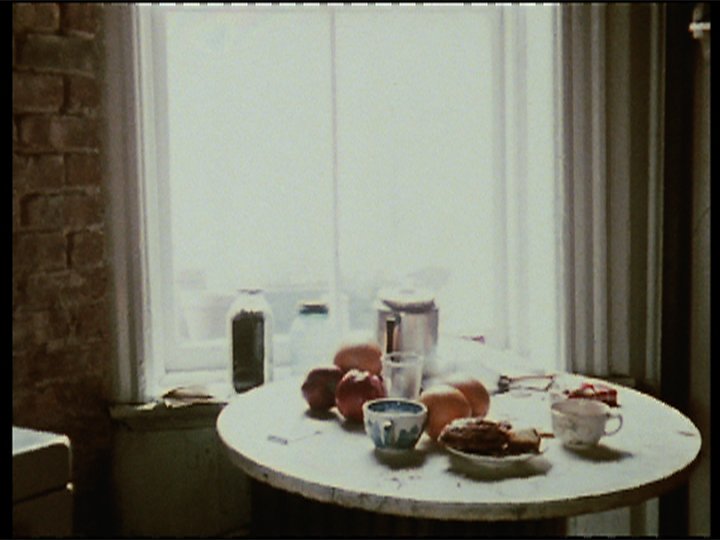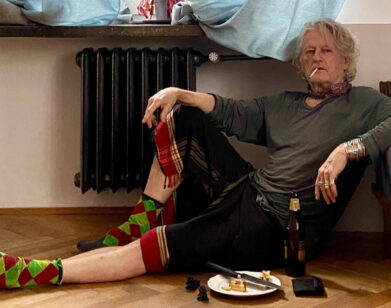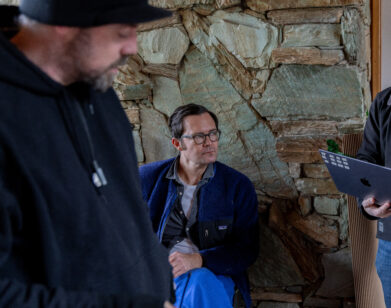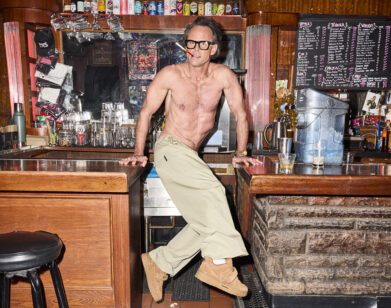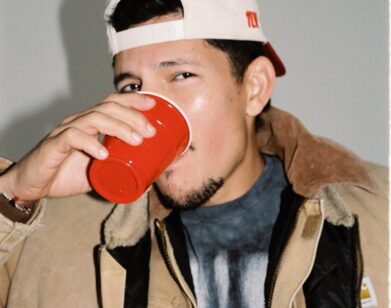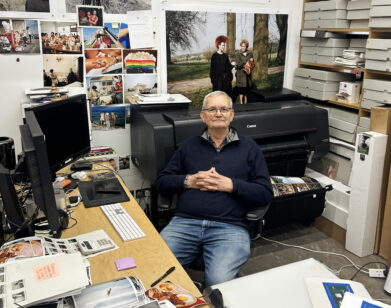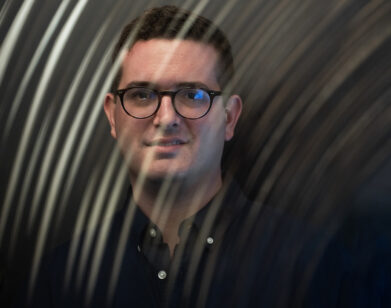The Education of Babette Mangolte
In 1972, cinematographer and director Babette Mangolte made her first film with Belgian filmmaker Chantal Akerman. La chambre, an elliptical, meditative 11-minute short, is one of those lengths of celluloid that commands the eye to surrender to an image. As Mangolte’s camera slowly pans 360-degrees around a small, disheveled tenement apartment, the viewer’s gaze fixes on a bowl of fruit, a teakettle, and the director herself, in bed, under the covers, or handling an apple, her position changed with each rotation of the camera. Akerman committed suicide last year, but the filmmaker’s output is one of the most varied, complex, and maddeningly exquisite in cinema. Her formal discipline, exhibited so exactingly in early films like Hôtel Monterey (1972) and her landmark feminist work, Jeanne Dielman, 23, Quai du Commerce, 1080 Bruxelles (1975), made when she was just 25, open up the mind to her deftly constructed ruminations on isolation, identity, and gender.
Mangolte, a prolific filmmaker in her own right, studied cinematography in Paris and left the capital’s male-run film industry to land in New York in 1970. She fell in with Jonas Mekas and Stan Brakhage and the downtown performance scene, shooting works by Yvonne Rainer, Robert Morris, and Trisha Brown, lensing Rainer’s films Lives of Performers (1972), Film About a Woman Who…(1974), and Kristina Taking Pictures (1976). Her directorial debut, The Camera: Je, premiered in 1977. When Mangolte and Akerman met in New York, it was fortuitous. As Mangolte says, the two desired to “find a language” to articulate the female perspective. Together, they made La chambre; Jeanne Dielman; Hôtel Monterey, a haunting nighttime study of a crumbling Upper West Side single-room-occupancy hotel. Their 1977 film News from Home is perhaps one of the most poetic accounts of New York City on film, constrasting Akerman’s voice as she reads letters from her mother at home in Brussels with visuals of the decaying metropolis.
Starting this Friday, BAM surveys Akerman’s legacy with their retrospective “Chantal Akerman: Images Between the Images,” which runs until May 1. Akerman’s career—from her first short, Saute ma ville [1968], up until her last feature, the documentary No Home Movie, a moving portrait of her mother, a Holocaust survivor who died in 2014—is presented in full. Interview met with Mangolte last week in New York to discuss her collaborations with Akerman, creative influences, and putting the feminine gesture on film.
COLLEEN KELSEY: When did you identify that image-making was what you were interested in?
BABETTE MANGOLTE: Very early, actually. I saw few films when I was a teenager, but when I arrived in Paris to go to university, there was the beginning of the New Wave. I was not very interested in the New Wave, but I was living in the Latin Quarter near the cinema. I was student, so I had a discount. It cost nothing, basically, and I could see two films for three francs at six and then at 10, so I discovered mostly silent cinema, American film and French film from the ’30s, and Russian film and Soviet film. What interested me in film was the image-making aspect of it. So, I went to school in cinematography. I was really convinced that image was what I wanted to do, and I think it came from the fact that I lived in a small town my whole life, but my mother was very interested in painting, so she would bring us to Paris for two weeks. So, we’re going to the Louvre and to the museums and to see shows. In the evening we were seeing theater. Painting is basically what led me. I think the image was key. I thought it was very interesting. I had no concept of how you could make a living doing filmmaking, frankly.
When the school told me I would have no chance to get a job, I said, “It’s irrelevant.” My mom was a feminist in the ’20s. She taught me to be on my own, to be independent, to do what I wanted to do. I did not believe it would be difficult. It was difficult. In ’66, I almost starved for a year and a half, and the only way I did not starve was because I could not find a job in camera, but I found a job in editing. I learned to become an editor, and that was a paid job so I could pay my rent. ’68 in Paris renewed my options. There was suddenly a desire of inventing new things, and I while I was working as an editor, the assistant editor thought I had a gift, and when he shot his own film, he hired me as his assistant camera, and I trained myself to do the light for him.
KELSEY: You said that you weren’t interested in the New Wave. Why was that?
MANGOLTE: Not really. I’m really interested in experimental works, so the people that I admired the most was Dziga Vertov, Eisenstein, people from the ’20s. Also, I loved John Ford and his westerns. The New Wave was not tender to women. I lived on the Left Bank, so I was more interested in the people considered “Left Bank,” which were Alain Resnais, Chris Marker, Agnès Varda, and so on. I met Alain Resnais, actually, when I was an assistant editor, I was in an editing room next to Resnais, who was editing The War is Over [1966]. I thought he was so elegant. Obviously I really admired Hiroshima Mon Amour [1959], and Muriel [1963] I thought was a masterpiece. I like Vivre sa vie [1962], I like The 400 Blows [1959]. It makes no sense to bad mouth people, but I think Godard is astonishing as a survivalist, somebody who can do a film that is as extraordinary as Goodbye to Language [2014]. In the ’60s when I started to see everything I could see, you could see pretty much everything which was still available from the ’30s, ’40s, ’50s, ’60s, and therefore I had an education which was really large and vast in different cinema. That’s probably the reason I did not fall for the New Wave. It’s really the love of the movies that made me want to become a cameraperson, definitely. I was really a film buff.
KELSEY: What was the shift in filmmaking climate like when you came from Paris to New York in 1970?
MANGOLTE: I came because I wanted to see my Michael Snow’s Wavelength [1967], which I had heard about from two different people, one loving the film and the other one detesting the film. I was introduced to somebody named Noël Burch. I met Noel in ’67 and he started a group, which I was part of, called Collective for Young Cinema, trying to get prints which had been censored by the government. So, we tried to circulate Statues Also Die [1953], which was a film that was censored of Resnais and Chris Marker, about the exploitation of African art.
I was stunned by this place, by the buildings, by the way of the streets. When I first arrived, I stayed with a friend who living in the Upper West Side near Central Park and I was walking to the Museum of Modern Art and I was taking the subway to go to visit Jonas Mekas in SoHo, who was going to open the Anthology Film Archive, in December 1970, designed by Peter Kubelka in the Lafayette building of the Public Theater. That was amazing. A friend I was staying with knew Jonas very well and knew Michael very well. I met Michael Snow and Stan Brakhage the second day after I arrived, you know. I had never seen or heard of Brakhage. For me, it was a revolution, because I was well educated in film, but American-style experimental film was known to me in the abstract, and I had seen practically nothing. I had seen a film then that Noël Burch had found and was distributing called Echoes of Silence. It was a beautiful film, three hours long. It goes forever and it was in black and white, very grainy, and I saw that film and I thought…it was not New Wave. It was really a new concept of cinema. I felt it was really important to come here to see what was happening in New York. So, I came to see film and accidentally I stumbled upon theater, so I discovered Andre Gregory, Richard Foreman, Robert Wilson, and theater became my first anchor.
KELSEY: How did you first connect with Chantal?
MANGOLTE: Chantal spoke to Marcel Hanoun, the filmmaker, and she said, “I want to go to New York. Do you know anybody?” He said, “Yes, I have a close friend who lives there. She is a camerawoman, she was my A.C. She’s going to shoot a film for me next year.” So, that’s how that happened. She came. She had my phone number.
KELSEY: What about your two sensibilities, of what you wanted from your work, matched? Why did you decide she’d be a good person to work with?
MANGOLTE: We were different in age, but we had something in common. We were women, we had been affected by the fact that the film world was a man’s world in Europe as much as here, actually. Now, I would have never gone to Hollywood. I was not interested in the film industry, frankly. The experimental film scene was very much misogynistic as well. I don’t know if you have read what little attention was given to the films of Joyce Wieland, who was the wife of Michael Snow. Michael was the “genius” and she was not. If you look at the films they’re wonderful, but very different. Michael was very proud of the films too, so it was not coming from him. It was coming from the general environment. I think both Chantal and I shared that. We wanted to find a language, which was the language of women.
When we shot La chambre, I was testing the camera of Robert Rauschenberg, which was used to shoot Yvonne Rainer’s Lives of Performers [1972]. I had a camera in my apartment on St. Mark’s Place and we used it to shoot the film. Chantal bought two rolls of films, and, that’s it, we shot it. In many ways, we discovered New York at the same time. I made her discover things. Although I’m older than her, I don’t think I ever was parenting. But, the main reason she wanted to meet me was because I was a cameraperson. She had done a second film with cameramen who totally bossed her around, and she could not stand it. She wanted to continue to make films and she felt then that she would be much better off if she was working with a woman, because they would have something in common.
KELSEY: Speaking on what you just said about having a mutual want to create a new language, how do you see that language being applied to a film like Jeanne Dielman, for example?
MANGOLTE: It definitely applies to Jeanne Dielman. In most films, activity was alluded to, very much in terms of speed. You go very fast on certain things. The way Chantal had conceptualized the script of Jeanne Dielman was as a short story, which was describing what she had observed. When Jonas [at a recent tribute to Akerman at Lincoln Center] mentioned that she was observer, that she soaked in things, she also looked at film, but she was not really a film scholar. She was interested in the new images, but she was also interested in communicating what she was feeling in her own experience. It was obvious then, in the case of Jeanne Dielman, the gesture, which was made by thousands of women, and was not really recognized as being important or meaningful. That was the topic of Jeanne Dielman. Those gestures of cooking, which implied time and attention and care. You have to buy the food, and so on and so on. All of that was the key of the film. It’s obvious then that it could have not been shot the same way by a man.
There’s plenty of men who have done beautiful films with very compelling women characters. For instance, Jean-Luc Godard’s vision is personified in Two or Three Things I Know About Her [1967]. Vivre sa vie is a beautiful film. Godard was also a really great scriptwriter, so he comprehended the perspective of somebody like Nana in Vivre sa vie. I read this after shooting Jeanne Dielman, but when he shot Vivre sa vie, it was very interesting to have a very heavy camera and to have very long shots. Many of the different episodes—the Twelve Stations of the Cross with Nana, are really constructed with duration. They gave room for her to exist. I never thought about it when I shot Jeanne Dielman, but it was stuck in my head. Jeanne Dielman was powerful because you really feel a woman there on the screen. That was absolutely connected with the idea of not doing what a man would have done. The other thing that was very important in the film was the fact that it was not a documentary. It was really stylized. It was done by one of the most intellectual actresses of a generation who could play many different registers. Delphine Seyrig was very diverse. I think what was very important was this idea of length of certain shots, and the fact then the film was stylizing the gesture, was discussed when we were shooting the film. It was not something that came accidentally. It was totally decided.
KELSEY: I feel this way about Hôtel Monterey, as well, that the duration really generates the narrative drama, and the viewer becomes almost compressed with either the camera or in Jeanne Dielman, with Delphine.
MANGOLTE: Yes. That’s very true. With Hôtel Monterey, Chantal had lived in that hotel for three or four weeks. I had lived in a hotel like that in the first year I was here on 23rd Street. Hers was uptown on Broadway. They were cheap, 25 dollars a week, you share a bathroom with somebody else. There were tons of people on welfare who were living in that hotel, and old people too. Chantal told me, “I want to do something about Hotel Monterey.” We went to visit the hotel and she got the idea that we should do 24 hours in the hotel. It was not 24 hours, but we started mid-afternoon. That was the concept she gave me basically. We shot it only in one day.
She knew certain people, so she had established contact, and she asked them to keep their doors open and engaged them, so she directed. She knew what she wanted to communicate. We had recorded some sound and she recorded more sound afterwards, coming back with a tape recorder. Hôtel Monterey was an important experience for me because the sound of the elevator, the door opening and closing, were actually the events, understand? The people were mostly there as static figures, basically.
KELSEY: News from Home was the last film you worked on with Chantal in New York. How did it come about?
MANGOLTE: She moved back to Europe, I think, in April ’73. News from Home was done because CDF, which is a German television company, produced work by independent filmmakers. They gave me money for one of films, for instance. But, the film was made because CDF wanted a film made by Chantal Akerman after Jeanne Dielman.
She worked on the concept of the image, of the script, over a period of one month. Obviously, she used the letters her mother had sent her when she was there in ’72. When she was there in ’76 to shoot News from Home, she was there just for two months, a month to write the script and think about what to do, and a month to do it. We shot it in ten days, I think. Then, she went back, where she edited the film. The film was done quickly, and represents, basically, what I think we felt when were discovering the film together, the linearity of the street…I always loved taking the ferry, which was very cheap, to go out to Staten Island. Chantal got the idea to use that shot, which is at the end of the film. You could say it was a no brainer, the way the city disappeared, because after all it is an island, and you always have to leave the city. That’s so charismatic, that shot.
There’s an element of improvisation in the way News from Home was done because it was done very simply. There was me as a cameraperson, there was an assistant named Jim Asbell, but there was also a car and someone driving doing the tracking shot. It was a pain putting the camera out on the street to do those static shots. We were going up with the sun, which was such an unbelievable shot, you know, and suddenly we see a woman outside, which I think is such a good shot, so we stopped to grab her. Jim had been my assistant before, in my film The Camera: Je, which had started to shoot. I trained him, so he could help me very fast to put up a tripod and do it quietly, and the woman did not move and we shot it. There was an element of randomness, but it was definitely something totally structured by Chantal, which was the idea that we were going to have something on 35th Street, we’re going to have something on the elevator of the subway, we’re going to 42nd Street. The shots had been rehearsed. I had done still photographs before going there with the movie camera, so it’s not that they were accidental. They were framed before. I think what was mapped was the intention to have the East Side, the West Side, mostly night, but also daytime, and people going to work. We have 5th Avenue, we have things with a diner. We have things, which actually would present New York at work during the day and dreaming at night, which is totally Chantal.
BAM’S CHANTAL AKERMAN: IMAGES BETWEEN THE IMAGES SERIES RUNS FROM APRIL 1 -MAY 1, 2016.

